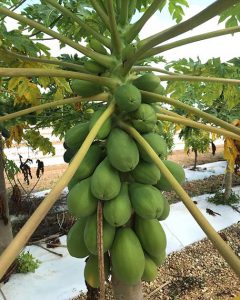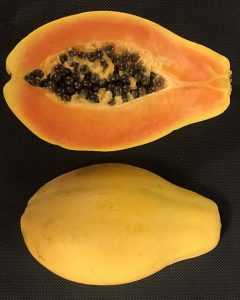Highlights:
- Papaya is an attractive fruit-bearing addition to homeowner landscapes, a key ingredient in savory dishes, and a delicious dessert fruit when picked ripe.
- South Florida’s climate provides a suitable year-round environment for commercial growers, who currently favor large-fruited varieties picked green and used in savory dishes.
- A University of Florida study takes a closer look at varieties, particularly ‘solo’ type papayas, that can provide South Florida commercial growers with additional options and a competitive edge in the dessert fruit market.

HOMESTEAD, Fla. – University of Florida scientists want to help South Florida farmers increase their economic returns when growing papaya to meet consumer demands and enhance their competitive edge domestically and internationally.
That’s why they embarked on a trial to find new varieties that grow well in South Florida and that possess valuable traits for future breeding work. Some of these new types included ‘solo’ type papayas that historically have not been widely grown in southern Florida.
“This research is timely as growers are looking for higher value crops that resonate with consumers,” said Alan Chambers, a tropical plant geneticist at the University of Florida Institute of Food and Agricultural Sciences (UF/IFAS). “Additionally, consumers are looking for novel fruit and fruit with superior quality.”
The results just released in Scientia Horticulturae, take a close look at 21 papaya varieties ripe for growing in South Florida for fruit quality, aroma, plant height and yield components.
“This work helped us identify diverse papaya cultivars that grow well in southern Florida. It also identified many types that should be avoided due to poor yield or quality,” Chambers said.
The trial, conducted at UF/IFAS Tropical Research and Education Center in Homestead, featured diverse papaya cultivars obtained from the United States Department of Agriculture Agricultural Research Service (USDA-ARS), and the Tropical Plant Genetic Resources and Disease Research unit in Hilo, Hawaii. Papaya cultivars are often categorized as either large papayas referred to as “Mexican” or “Formosan” papayas, or small, pear-shaped papayas known as ‘solo’ types.

“One of our major objectives in the trial identifies the best ‘solo’ type papaya for southern Florida. These papayas are worth more than common papayas, and they have a superior flavor,” he added. “‘Solo’ type papayas are a good option for those looking to diversity their crops. We think that ‘solo’ papayas are an attractive option for more people because they lack the “musky” aroma that is so unfavorable to many people.”
Papaya is popular, versatile and can yield a crop within the first year after planting — a rare feature among perennial tropical fruits. Unfortunately, expansion of the papaya industry in South Florida is hindered by low prices and a lack of varieties resistant to the papaya ringspot virus (PRSV).
“We are working to address these challenges through our papaya research and breeding program,” said Sarah Brewer, a graduate research assistant on the team. “Through this trial, we have identified papaya varieties with excellent fruit quality characteristics and strong performance in the field. We are now using these varieties in our breeding program, in combination with PRSV-resistant lines. The ultimate goal is to develop virus-resistant, ‘solo’ papayas that grow well here in Miami-Dade County.”
Cultivation of ‘solo’ papayas in South Florida may benefit both growers and consumers, said Brewer.
“‘Solo’ papayas are well known for their superior sweetness and flavor. Many of the ‘solo’ papaya varieties in this trial were estimated to have higher sugar content than the large-fruited ‘Maradol’ variety,” she said.
The study also found the aroma in papaya varieties differed significantly. For example, the red ‘solo’ papaya varieties ‘Sunset,’ ‘Sunrise,’ and N08-75 were especially low in chemical compounds that may negatively affect fruit flavor for consumers,” said Brewer.
“In addition to delighting consumers with outstanding flavor, ‘solo’ papayas may entice growers with the potential for higher profits,” said Brewer. “In 2020, ‘solo’ papayas retailed for nearly one and half times the price of ‘Maradol’ and other large-fruited varieties.”
The United States is the leading importer of papaya with 192,070 metric tons in 2019, or about 70 percent of all internationally traded papaya. Papaya is cultivated throughout tropical and subtropical regions of the world including South and Central America, the Caribbean, Southeast Asia, India, Africa, Australia, and the Pacific Islands. As of 2018, annual global production of papaya exceeded 13 million metric tons, making it the fourth most popular tropical fruit after bananas, mango and pineapple.
Papaya is also produced domestically, though climate restricts cultivation primarily to Hawaii, Puerto Rico, California, Texas and Florida.
The opportunity to grow papayas is dependent on the climate and availability of locally adapted varieties. South Florida’s subtropical climate possesses ideal growing conditions for papayas in the continental United States.
Papayas are grown year-round, largely in the Miami-Dade County area, with the largest production occurring during the summer and fall. In recent years, the local growing community has favored growing for the green market. Identification of ‘solo’ papaya varieties that perform well in southern Florida and command a premium price may facilitate expansion of the dessert fruit market and an increase in profitable papaya acreage.
-30-
By: Lourdes Mederos, rodriguezl@ufl.edu
The mission of the University of Florida Institute of Food and Agricultural Sciences (UF/IFAS)
is to develop knowledge relevant to agricultural, human and natural resources and to make
that knowledge available to sustain and enhance the quality of human life. With more than
a dozen research facilities, 67 county Extension offices, and award-winning students and faculty
in the UF College of Agricultural and Life Sciences, UF/IFAS brings science-based solutions
to the state’s agricultural and natural resources industries, and all Florida residents.
 0
0
